The Problem:
Municipalities and private owners are held liable for damages caused by their trees.Most often trees are broken or thrown because of decay by fungal infections. To avoid risks the safety of trees has to be assessed on a regular basis.The usual investigation methods and devices need several years of experience, inspect only small parts of the trunk, or cause several injuries (e.g. increment borers, penetrometers). Their range of application is there limited. The PiCUS Sonic Tomograph is a tool to assess the stability of trees and timber objectively and non-destructively. It is easy to apply and yields precise results.

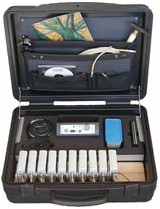
Application:
The measuring principle is based on the fact that sound wood is a better sound wave conductor than wood damaged by decay.The PiCUS Sonic Tomograph consists of 8 to 14 sonic sensors. These sensors are spaced out evenly around the circumference of the trunk. They detect stress waves induced by manual impact and propagated through the wood. Time-of-sound-transmissions are used to generate two-dimensional pictures that document decay and cavities.
A tomogram is attained as follows:
1. Mounting the magnetic sensors to the tree by using small roof nails. Recording the geometry of the treexs cross-section. In most cases two perpendicular measurements with a calliper suffice. If not, the software provides assistance for a detailed description of the geometry.
2. Induction of stress waves: a slight tap on each sensor. All other sensors measure the velocity of the stress waves. The pocket PC controls the measurement and stores the data.
3. The Pocket PC shows the result of the measurement graphically right at the tree.
4. Documentation: all results can be printed or copied into standard office software.
How to record a PiCUS Sonic Tomogram (SoT)
1. Determine the level, number, and positions of measuring points on the tree
To determine the measuring level, first conduct a thorough visual inspection of the tree and also a sound evaluation with the mallet. Look for external signs of internal defects, such as fungus growth, cracks, cavities, damaged bark, etc. Use all of your knowledge about trees and diseases and choose the measuring level according to your visual assessment of the tree.
2. Measuring the geometry of the tree at the measuring level
There are several ways to enter the geometry of the tomography test level.
Simple circular geometry
Elliptical geometry
Free shape geometry - Triangulation

The PiCUS Calliper can efficiently carry out the triangulation measurements needed to calculate the exact positions of each measuring point. Using the electronic PiCUS calliper allows you to plot any tree shape quickly and accurately.
3. Taking sonic measurements
The sonic impulse is generated on each measuring point (nail) and recorded on the sensors at the other points. The electronic hammer (photo on the left) allows to use fewer sonic sensors than measuring points. This enables you to use smaller PiCUS systems in a fully functional manner.
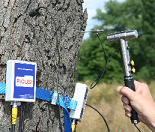
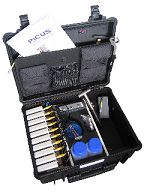
The PiCUS equipment is supplied with a robust box.
4. Calculating a Tomogram
The sonic tomogram of a tree can be calculated on site using a number of functions for data analysis and presentation. Size and location of defets is shown using distinct colours. Tomograms of a tree can be displayed in 3-dimensional graphics.
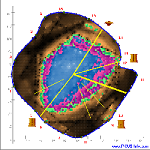
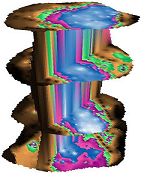
There are assistance-functions that help to analyse the tomogram. The tomogram (jpg-image) can by copied into other programs.
System specification:
- The PiCUS Sonic Tomograph generates two-dimensional images of a slice of a trunk. It can be used for trees even larger than 2 m (6,5 ft.) in diameter.
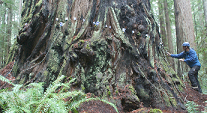
The largest tree we have ever tested was this sequoia sempervirens (a redwood in California), which was over 5 meters in diameter. The image shows a test by argus electgronic and Philip van Wassenaer on that tree. To take the measurements, we placed 66 MP but only needed to use 16 sensors.
- It is integrated into a robust case with an integrated power supply and it is therefore best suited to be operated for several hours in the field.
- The resolution of the system depends on tree size and on the number of sensors. The number of sensor of the standard version is sufficient for most practical application. For higher resolution additional sensors can be added to the sensor chain.
- A Pocket PC is used to control the sensors in the field. To analyse, print and save the measurements a
Windows PC 98/ME/2000/XP software is provided.

Advantages:
• easy to apply
• flexibly due to sensor chain
• accurate results locally
• short measurement time
• nearly non-destructive
• PocketPC optional
Limitations
Cracks in wood are real barriers for the sonic waves. They appear in the tomogram much larger than they really are and may thus lead to incorrect conclusions about the tree. To identify “star shaped” cracks, the PiCUS software contains a CrackDect Function. We also recommended using other inspection methods, such as the Treetronic electric impedance tomography.
Producing Area:Germany